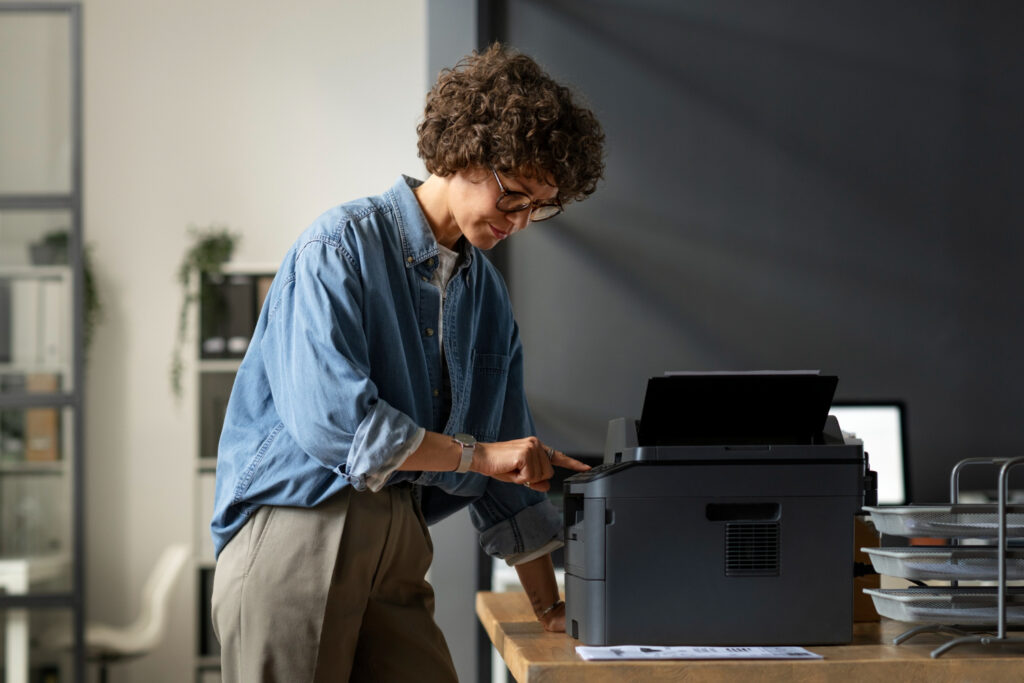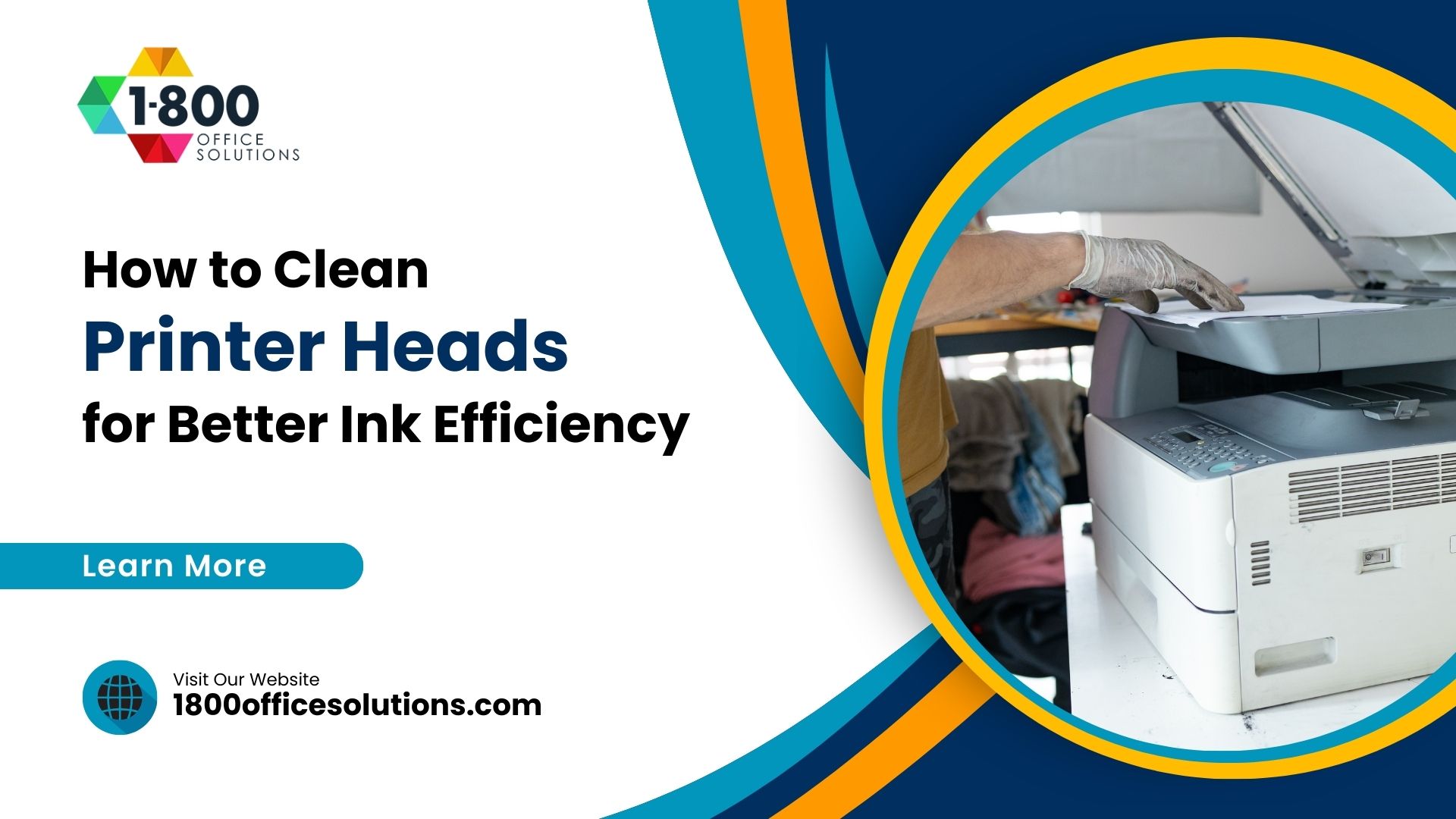Troubleshooting Common Printer Issues: The Quick Fixes Your Office Needs Now
Introduction
In today’s fast-paced office environment, printers play a crucial role in daily operations. From printing essential documents to creating marketing materials, printers are indispensable tools. However, common printer problems often arise, causing delays and frustration. Whether it’s a paper jam, low ink, or connectivity issues, these challenges require quick fixes to keep the workflow smooth.
In this blog post you’ll get a comprehensive guide about troubleshooting common printer issues and how to maintain your office or business printer.
The need for quick solutions stems from the fact that office productivity often hinges on the ability to use your printer efficiently. A malfunctioning printer can lead to significant delays in tasks, affecting the overall performance of the team. Printer Maintenance Guide provides comprehensive insights into maintaining and troubleshooting printers, ensuring that common problems are addressed promptly.
Understanding the common challenges and how to fix them is essential for every office. Whether it’s a new printer or an older printer model, knowing the troubleshooting common printer issues section of the printer manual and having a set of quick fixes at hand can save valuable time.
Common Printer Problems and Solutions
Paper Jams
- Causes and Prevention: Paper jams are a common problem that can be caused by using the wrong type of paper, misalignment, or overloading the tray. To prevent this, always check the printer settings and use the recommended type of paper. Regular maintenance and cleaning can also minimize the risk.
- Quick Fixes: If a paper jam occurs, first turn off the printer and carefully remove the sheet of paper without tearing it. Check the printer manual for specific instructions for your printer model. Regularly inspecting the paper tray and rollers can help solve the problem and prevent future occurrences.
Faded or Wavy Printouts
- Low Toner Issues: Faded printouts are often a result of low ink or toner. Checking the ink cartridge or toner levels and replacing them when needed ensures consistent print quality. Always use cartridges recommended by the printer manufacturer to avoid compatibility issues.
- Alignment of Printer Components: Misalignment of printer components can lead to wavy printouts. Regular calibration and alignment checks, as per the printer manual, can prevent this issue. If the problem persists, professional servicing may be required.
Inkjet Printer Nozzle Issues
- Dry Nozzles: Inkjet printer nozzles can dry out if not used regularly, leading to poor print quality. Running a cleaning cycle through the printer settings can often resolve this issue. If not, manual cleaning with a soft cloth and alcohol may be necessary.
- Clogged Nozzles: Clogged nozzles are a common cause of problems in inkjet printers. Regular cleaning cycles and using the right type of ink can prevent this. If clogging occurs, manual cleaning with specialized tools may be required.
- Cleaning Techniques: Regular cleaning of the nozzles ensures optimal performance. Utilizing the printer’s built-in cleaning function or following the troubleshooting section in the manual can keep the nozzles in good condition. Inkjet Printer Troubleshooting offers step-by-step instructions for fixing common inkjet printer issues.
- Checking Printer Configuration: Wireless printer configuration issues can disrupt printing. Ensuring that the printer is correctly configured with the router and that the printer settings are accurate can resolve this problem.
- Pinging IP Address: If the printer is not responding, pinging the IP address can help identify connectivity issues. A successful ping indicates that the network connection is stable.
- Changing Network Cable: Faulty network cables can lead to connectivity issues. Regular inspection and replacement of damaged cables can ensure uninterrupted Wi-Fi printing.
Laser Printers Troubleshooting
- Replacing Toner Cartridge: Laser printer toner cartridges need regular replacement. Using the correct ink cartridge and following the replacement guidelines in the printer manual ensures consistent print quality.
- Dealing with Ghost Images: Ghost images on printouts can be a result of a faulty drum or toner. Regular inspection and replacement of these components can eliminate this issue.
- Handling Image Distortion: Image distortion in laser printers can be due to misalignment or wear and tear of components. Regular maintenance, alignment checks, and using the right sheet of paper can help solve the problem.
Advanced Troubleshooting Common Printer Issues
This section provides a comprehensive guide to common printer problems and how to fix them. Whether it’s an inkjet printer, laser printer, or wireless printer, understanding the underlying issues and having the right solutions at hand can significantly reduce downtime and enhance productivity.
Regular maintenance, adherence to manufacturer guidelines, and awareness of how to troubleshooting common printer issues are key to maximizing the efficiency of your office printers.
Advanced Troubleshooting Techniques
Diagnostic Software Utilization
- Manufacturer-Provided Tools: Many printer brands offer diagnostic tools specifically designed for their products. These tools can identify the 10 most common printer problems and provide solutions. Utilizing these tools can be an easy way to fix printer issues without needing a printer technician.
- Third-Party Solutions: There are also third-party diagnostic tools that can fix printer problems across different brands. These tools can be particularly useful if you have many printers from various manufacturers. They often come with features to check your printer configuration, software problems, and more.
Driver Reinstallation and Updates
- Removing Old Drivers: Outdated or corrupted drivers can cause printing problems. Uninstalling the old driver for your printer and removing associated files can often fix this issue. Make sure to follow the guidelines in the printer manual for proper removal.
- Installing Latest Versions: 1800 Office Solutions Tips emphasizes the importance of keeping the drivers updated. Installing the latest versions ensures compatibility and can resolve many common printing issues. Always download drivers from the official website of the printer manufacturer to avoid potential risks.
Memory and CPU Upgrades
- Enhancing Printing Speed: Upgrading the memory and CPU of the printer can significantly enhance printer speed. This is particularly beneficial for offices that require high-volume printing. Consult the specific printer model manual to understand the compatible hardware.
- Compatible Hardware Selection: Choosing the right hardware is crucial. Incompatible upgrades may lead to more problems. Always consult the printer manual or a professional technician to select the right components for your type of printer.
Routine Maintenance Requirements
- Scheduled Cleaning: Regular cleaning inside the printer ensures that dust and debris don’t cause problems. Scheduled cleaning, as per the manufacturer’s guidelines, can prevent many common issues.
- Regular Inspections: Regular inspections of the printer can identify wear and tear or potential issues before they become major problems. This includes checking the paper in the tray, alignment, ink and toner levels, and more.
Maintenance and Cleaning
Cleaning the Paper Feed Rollers
Procedure
Cleaning the paper feed rollers is a vital maintenance task that ensures the smooth operation of your printer. Here’s a step-by-step guide to the process:
- Turn Off the Printer: Always turn off the printer before cleaning to ensure safety. Unplug it from the power source to prevent any electrical issues.
- Open the Access Panel: Locate the access panel, usually found on the front or back of the printer. Refer to the printer manual for specific instructions for your printer model.
- Inspect the Rollers: Check the rollers for visible dust, grime, or wear. This will give you an idea of how thorough the cleaning needs to be.
- Prepare a Damp Cloth: Use a soft cloth dampened with water or a mild cleaning solution. Avoid using harsh chemicals, as they can damage the rollers.
- Gently Wipe the Rollers: Carefully wipe the rollers, applying gentle pressure to remove dust and grime. Make sure to clean all sides of the rollers.
- Dry the Rollers: After cleaning, use a dry cloth to remove any moisture from the rollers. Allow them to air dry for a few minutes before closing the access panel.
- Test the Printer: Plug the printer back in and turn it on. Try printing a test page to ensure that the paper feeds smoothly.
- Schedule Regular Cleaning: Depending on the usage and environment, schedule regular cleaning of the rollers. This could be monthly or quarterly.
Importance
The importance of regular cleaning of the paper feed rollers cannot be overstated. Here’s why it’s crucial:
- Prevents Paper Jams: Dust and grime on the rollers can cause the paper to feed unevenly, leading to paper jams. Regular cleaning prevents this common issue.
- Ensures Print Quality: Dirty rollers can affect the sides of the paper as it feeds through, leading to smudges or uneven printing. Cleaning ensures consistent print quality.
- Extends Roller Lifespan: Regular maintenance can extend the life of the rollers, preventing wear and tear. This saves money on replacements and keeps the printer running efficiently.
- Avoids Major Printer Problems: Neglected rollers can lead to more significant issues over time, including damage to other parts of the printer. Regular cleaning is an easy to fix preventive measure.
- Contributes to Sustainability: Proper maintenance of the rollers contributes to the overall sustainability of the printer, reducing waste and the need for new parts.
- Enhances Printer Speed: Clean rollers feed paper more efficiently, enhancing the printer speed. This can be particularly beneficial in a busy office environment.
- Improves Reliability: A printer that’s well-maintained, including clean rollers, is more reliable. This means fewer interruptions and more efficient use of the printer.
Cleaning the paper feed rollers is a simple yet essential task that can have a significant impact on the performance and longevity of your printer. Whether you have a home printer or manage a fleet of office printers, incorporating this cleaning procedure into your regular maintenance routine can prevent many common printer problems and solutions, ensuring that your printer is always ready to perform when you need it.
Toner and Cartridge Management
Replacing and Recycling
Managing ink and toner cartridges is a vital aspect of printer maintenance. Here’s a detailed look at replacing and recycling cartridges:
- Identifying the Need for Replacement: Monitoring the ink or toner levels is essential. Most printers provide alerts or indicators when the levels are low. Regular checks can prevent poor print quality due to low ink or toner.
- Selecting the Right Cartridge: Always choose cartridges that are specifically designed for your printer model. Using the wrong type can lead to common printer problems and solutions.
- Replacement Procedure:
- Turn the Printer Off: Make sure the printer is turned off to avoid any electrical issues.
- Open the Cartridge Compartment: Refer to the printer manual for specific instructions on accessing the cartridge compartment.
- Remove the Old Cartridge: Carefully remove the old cartridge, avoiding any contact with the ink or toner.
- Insert the New Cartridge: Align the new cartridge properly and gently insert it into the compartment.
- Test the Printer: Print a test page to ensure that the new cartridge is working correctly.
- Recycling Programs: Many printer brands offer recycling programs for used cartridges. Participating in these programs promotes sustainable practices and reduces waste. Check with the manufacturer or local recycling centers for details.
Proper Handling
Proper handling of cartridges is crucial to prevent leaks, damage, and other issues. Here’s a guide to handling cartridges correctly:
- Storage: Store unused cartridges in their original packaging in a cool, dry place. Exposure to extreme temperatures or sunlight can affect the ink or toner quality.
- Handling During Replacement:
- Use Gloves: Wearing gloves can prevent ink or toner stains on your hands.
- Avoid Shaking: Shaking a cartridge can cause leaks or uneven ink or toner distribution.
- Align Properly: Proper alignment during installation is crucial. Misalignment can lead to printing issues and potential damage.
- Avoid Touching Sensitive Parts: The print head and other sensitive parts of the cartridge should not be touched. Finger oils and dirt can cause clogs and other problems.
- Follow Manufacturer Guidelines: Always refer to the printer manual for specific instructions on handling cartridges for your specific printer model. This ensures that you follow the best practices for your particular printer.
- Dispose of Properly: If not recycling, dispose of used cartridges as per local regulations. Incorrect disposal can be harmful to the environment.
- Consider Refilling: Some cartridges can be refilled, providing a cost-effective and environmentally friendly option. Check with the manufacturer or a professional refilling service to see if this is suitable for your cartridge type.
General Printer Cleaning
- Exterior and Interior Cleaning: Regular cleaning of the exterior and interior of the printer prevents dust accumulation. Use a soft cloth for the exterior and a gentle vacuum for the interior. Make sure to unplug the printer before cleaning.
- Safety Precautions: Safety is paramount when cleaning the printer. Always turn the printer off and unplug it. Avoid using excessive moisture, and follow the guidelines in the printer manual to prevent damage.
What People Also Ask
How to deal with spool errors?
Spool errors are often related to software problems or conflicts with other print jobs. You can fix the issue by opening your printer utility, canceling all print jobs, and restarting the spooler service. If you're still having problems, reinstalling the printer driver might be necessary.
What to do if the printer is noisy due to jam paper or broken parts?
Noisy printers may indicate jammed paper or broken parts. First, unplug the printer and check inside for any visible obstructions. Carefully remove any jammed paper. If the printer is still noisy, consult the printer manual or contact a technician, as there may be a problem with internal components.
How to handle spots in print due to faulty toner or laser drum?
Spots in print can be a common issue with faulty toner or laser drum. Check the printer manual for specific cleaning instructions. If cleaning doesn't fix the problem, replacing the toner or drum with ones specifically designed for your printer model might be the way to fix it.
What are the steps to clean the print head if it's dirty?
Cleaning a dirty print head involves accessing the cleaning function in the printer utility. Many Wi-Fi printers support AirPrint and other wireless printing options that allow you to initiate cleaning remotely. If manual cleaning is required, consult the printer manual for specific instructions, and use gentle cleaning solutions to avoid damage.
Conclusion
The world of printers is vast, encompassing various types, from inkjet to laser, virtual printer to Wi-Fi printer. Understanding how to troubleshoot and maintain these devices is essential for smooth office operations. This guide has covered everything from advanced troubleshooting techniques to routine maintenance, addressing the common complaints and providing solutions.
From learning how to get your printer to print with the right paper for your printer to understanding printer placement and connectivity with Wi-Fi network, the insights provided here aim to empower users to handle common printer problems and solutions.
Nearly all major printer manufacturers provide extensive support and guidelines to ensure optimal performance. Regular adherence to these guidelines, coupled with a proactive approach to maintenance, can make most printer issues easy to fix. Whether you have a printer at home or in a bustling office, these insights will help you keep your printer running smoothly, ensuring that you can always use a printer when you need it.
Printer Maintenance Guide and Network Printer Configuration Tips are valuable resources that provide further insights into maintaining and troubleshooting printers. By embracing these practices and understanding the common reasons behind printer issues, you can ensure that your printer remains a reliable tool in your daily tasks, contributing to a more sustainable and efficient work environment.












